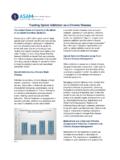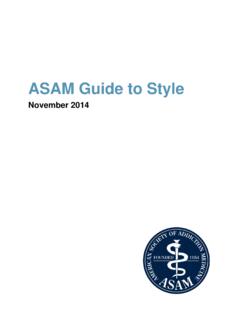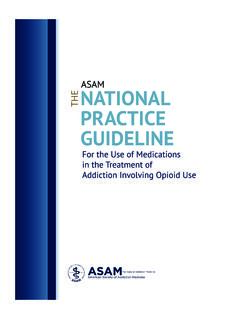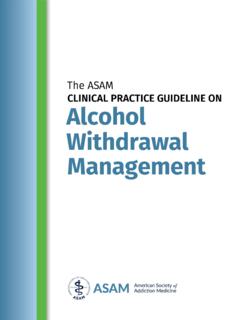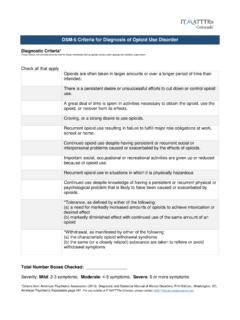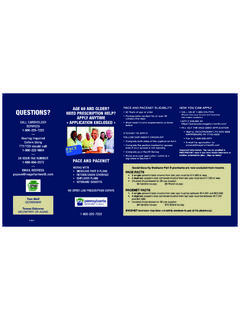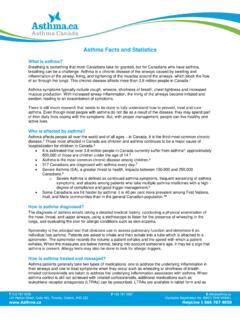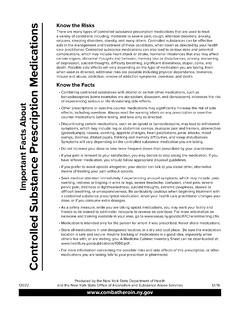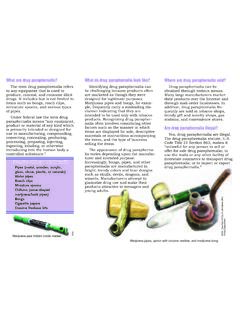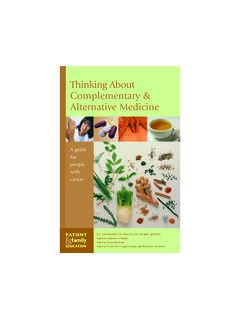Transcription of Opioid Addiction 2016 Facts & Figures
1 Opioid Addiction 2016 Facts & Figures Opioid Addiction Opioids are a class of drugs that include the illicit drug heroin as well as the licit prescription pain relievers oxycodone, hydrocodone, codeine, morphine, fentanyl and Opioids are chemically related and interact with Opioid receptors on nerve cells in the brain and nervous system to produce pleasurable effects and relieve Addiction is a primary, chronic and relapsing brain disease characterized by an individual pathologically pursuing reward and/or relief by substance use and other Of the million Americans 12 or older that had a substance use disorder in 2015, 2 million had a substance use disorder involving prescription pain relievers and 591,000 had a substance use disorder involving It is estimated that 23% of individuals who use heroin develop Opioid National Opioid Overdose Epidemic Drug overdose is the leading cause of accidental death in the US, with 52,404 lethal drug overdoses in 2015.
2 Opioid Addiction is driving this epidemic, with 20,101 overdose deaths related to prescription pain relievers, and 12,990 overdose deaths related to heroin in From 1999 to 2008, overdose death rates, sales and substance use disorder treatment admissions related to prescription pain relievers increased in parallel. The overdose death rate in 2008 was nearly four times the 1999 rate; sales of prescription pain relievers in 1 National Institute on Drug Abuse. (2015). Drugs of Abuse: Opioids. Bethesda, MD: National Institute on Drug Abuse. Available at 2 American Society of Addiction Medicine.
3 (2011). Public Policy Statement: Definition of Addiction . Chevy Chase, MD: American Society of Addiction Medicine. Available at 3 Center for Behavioral Health Statistics and Quality. (2016). Key substance use and mental health indicators in the United States: Results from the 2015 National Survey on Drug Use and Health (HHS Publication No. SMA 16-4984, NSDUH Series H-51). Retrieved from 4 National Institute on Drug Abuse. (2014). Drug Facts : Heroin. Bethesda, MD: National Institute on Drug Abuse. Available at 5 Rudd RA, Seth P, David F, Scholl L. Increases in Drug and Opioid -Involved Overdose Deaths United States, 2010 2015.
4 MMWR Morb Mortal Wkly Rep 2016;65:1445 1452. DOI: 2010 were four times those in 1999; and the substance use disorder treatment admission rate in 2009 was six times the 1999 In 2012, 259 million prescriptions were written for opioids, which is more than enough to give every American adult their own bottle of Four in five new heroin users started out misusing prescription 94% of respondents in a 2014 survey of people in treatment for Opioid Addiction said they chose to use heroin because prescription opioids were far more expensive and harder to obtain. 9 Impact on Special Populations Adolescents (12 to 17 years old) In 2015, 276,000 adolescents were current nonmedical users of pain reliever, with 122,000 having an Addiction to prescription pain In 2015, an estimated 21,000 adolescents had used heroin in the past year, and an estimated 5,000 were current heroin users.
5 Additionally, an estimated 6,000 adolescents had heroin a heroin use disorder in People often share their unused pain relievers, unaware of the dangers of nonmedical Opioid use. Most adolescents who misuse prescription pain relievers are given them for free by a friend or The prescribing rates for prescription opioids among adolescents and young adults nearly doubled from 1994 to Women Women are more likely to have chronic pain, be prescribed prescription pain relievers, be given higher doses, and use them for longer time periods than men. Women may become dependent on prescription pain relievers more quickly than 48,000 women died of prescription pain reliever overdoses between 1999 and 6 Paulozzi MD, Jones PharmD, Mack PhD, Rudd MSPH.
6 Vital Signs: Overdoses of prescription Opioid Pain Relievers United State, 1999-2008. Division of Unintentional Injury Prevention, National Center for Injury Prevention and Control, Center for Disease Control and Prevention. 2011:60:5. 7 Centers for Disease Control and Prevention. (2014). Opioid Painkiller Prescribing, Where You Live Makes a Difference. Atlanta, GA: Centers for Disease Control and Prevention. Available at 8 Jones CM. Heroin use and heroin use risk behaviors among nonmedical users of prescription Opioid pain relievers - United States, 2002-2004 and 2008-2010. Drug Alcohol Depend.
7 2013 Sep 1;132(1-2):95-100. doi: Epub 2013 Feb 12. 9 Cicero TJ, Ellis MS, Surratt HL, Kurtz SP. The changing face of heroin use in the United States: a retrospective analysis of the past 50 years. JAMA Psychiatry. 2014;71(7):821-826. 10 National Institute of Drug Abuse. (2015). Drug Facts : prescription and Over-the-Counter Medications. Bethesda, MD: National Institute of Drug Abuse. Available at 11 Fortuna RJ, Robbins BW, Caiola E, Joynt M, Halterman JS. Prescribing of controlled medications to adolescents and young adults in the United States. Pediatrics. 2010;126(6):1108-1116. 12 Center for Disease Control and Prevention.
8 (2013). prescription Painkiller Overdoses: A Growing Epidemic, Especially Among Women. Atlanta, GA: Centers for Disease Control and Prevention. Available at prescription pain reliever overdose deaths among women increased more than 400% from 1999 to 2010, compared to 237% among Heroin overdose deaths among women have tripled in the last few years. From 2010 through 2013, female heroin overdoses increased from to per 100, 13 Hedegaard H, Chen LH, Warner M. Drug-poisoning deaths involving heroin: United States, 2000 2013. NCHS data brief, no 190.
9 Hyattsville, MD: National Center for Health Statistics. 2015. Available at
